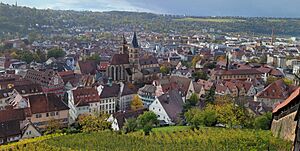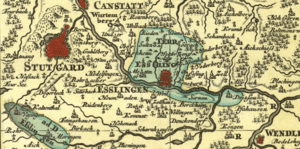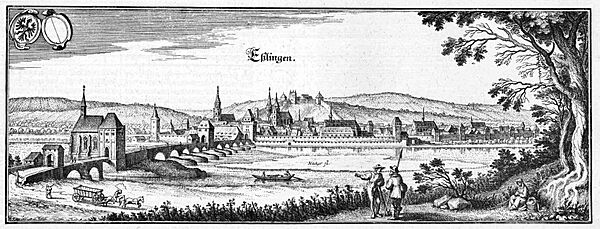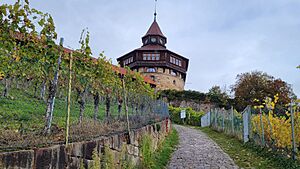Esslingen am Neckar facts for kids
Quick facts for kids
Esslingen am Neckar
|
||
|---|---|---|
 |
||
|
||
| Country | Germany | |
| State | Baden-Württemberg | |
| Admin. region | Stuttgart | |
| District | Esslingen | |
| Elevation | 241 m (791 ft) | |
| Population
(2022-12-31)
|
||
| • Total | 94,941 | |
| Time zone | CET/CEST (UTC+1/+2) | |
| Postal codes |
73701–73734
|
|
| Dialling codes | 0711 | |
| Vehicle registration | ES | |
| Website | www.esslingen.de | |
Esslingen am Neckar is a cool town in southern Germany, located in the Stuttgart Region of Baden-Württemberg. It's the main town of the Esslingen district and the biggest town there. Esslingen is also the 11th largest city in Baden-Württemberg.
The town sits right on the Neckar river, about 14 kilometers (9 miles) southeast of Stuttgart city center. The areas around Esslingen are quite developed.
For many centuries, Esslingen was a free imperial city, meaning it was independent and ruled itself. But in 1802, it became part of Württemberg. The famous German Timber-Frame Road, which features many old wooden houses, also passes through Esslingen.
Contents
- Esslingen's History: A Journey Through Time
- Getting Around: Transport in Esslingen
- Esslingen University of Applied Sciences
- Sister Cities: Esslingen's Global Friends
- Famous People from Esslingen
- See also
Esslingen's History: A Journey Through Time
Ancient Times: Early Settlers in Esslingen
Archaeologists have found proof that people lived in the area of Esslingen a very long time ago. Traces of human settlement near the city church date back to about 1000 B.C., which was during the Neolithic period.
Roman Era: Esslingen as a Roman Hub
In the 1st century AD, the Esslingen region became part of the powerful Roman Empire. During this time, the Romans had a warehouse in the Oberesslingen area. Important Roman towns and army bases were nearby in Cannstatt and Köngen.
Early Middle Ages: From Alemanni to Merovingians
The name "Esslingen" comes from an old German word meaning "the peoples of Azzilo." Azzilo was likely an important landlord or family leader. The town's name was first written down in 856 as Ezlinga.
In the 6th century, the Merovingians took control of the Alemanni people. The Alemanni still helped with local tasks and formed a duchy (a type of kingdom) within Francia. Later, they tried to become independent again, but they didn't succeed.
Archaeologists have found signs of early settlements from the late Merovingian period under the St. Dionysius church. Even older graves have been found in Oberesslingen and Sirnau.
Medieval Esslingen: A Growing Trade Center
Esslingen was first mentioned in a written document in 777. This was in the will of Abbot Fulrad from Saint-Denis in France. He gave a place on the Neckar river to his monastery. He also brought the bones of Saint Vitalis to Esslingen. This made Esslingen a popular spot for pilgrims, which helped the town grow.
Around 800, Esslingen became a market town, meaning it had special rights to hold markets. These rights were officially confirmed in 866. In 1229, Esslingen received city rights from Emperor Frederick II. Around the same time, the Neckar bridge was built. This bridge made Esslingen a very important trading center for goods traveling between Italy, Switzerland, and northern Germany. Taxes from the bridge and market, along with the export of local wines, helped the town grow even more.
Between the 13th and 16th centuries, Esslingen, as a Free Imperial City, often had conflicts with the Counts of Württemberg. The Thirty Years' War (1618–1648) was a very tough time for Esslingen. About half of the people died from hunger or sickness. Esslingen lost its independence in 1802–1803 during the Napoleonic era and became part of the Duchy of Württemberg.
The city had a strong defensive wall, and some parts of it are still standing today. One famous part is "The Fat Tower" (Der Dicke Turm), which is located on a hill among vineyards above the city.
Modern Era: Industry and Growth
The 19th century brought big changes with the start of the Industrial Revolution. Esslingen became known for making gloves, processing food, textiles, and metal products. On November 20, 1845, the first train arrived at Esslingen station from Cannstatt.
At the end of World War II, in April 1945, U.S. troops took over Esslingen. The city was lucky because it wasn't badly damaged during the war. It was given up peacefully to the Allied forces, so its old medieval city center is still well-preserved.
After World War II, about 47,000 people moved to Esslingen. Many were refugees from East Germany. New housing areas were built in Oberesslingen and Zollberg to help everyone find a place to live.
In 1973, the Nürtingen district joined with Esslingen am Neckar. This made Esslingen the main town of a much larger district.
Esslingen is a diverse city. Here are some of the largest groups of people from other countries living in Esslingen as of December 31, 2020:
| 4,182 | |
| 3,030 | |
| 2,051 | |
| 1,711 | |
| 1,248 | |
| 1,102 | |
| 784 | |
| 713 | |
| 708 | |
| 472 |
Getting Around: Transport in Esslingen
Air Travel: Stuttgart Airport Nearby
Stuttgart Airport, the biggest airport in Baden-Württemberg, is very close to Esslingen. It's about 10 kilometers (6 miles) south of the town. A Lufthansa airplane has even been named after Esslingen!
The Bundesautobahn 8 (A8) highway, which goes from Karlsruhe to Munich, has an exit for Esslingen right after the airport when you're heading towards Munich.
Roads: Driving in and Around Esslingen
Esslingen is directly on the B10 State Highway. This highway is a dual carriageway (like a mini-highway) that goes from Stuttgart to Süßen and then continues to Ulm. The exit for Esslingen is special because it has two entry and exit points when you're going towards Ulm. This means you can get to central Esslingen easily from Stuttgart. You can also drive directly onto the highway towards Ulm from central Esslingen without stopping at traffic lights.
Even with many lanes on the new Pliensau Bridge and nearby roads, traffic can still get busy, especially around Pliensauvorstadt and the route to Zollberg.
Esslingen is also part of the German Timber-Frame Road, a scenic route known for its historic timber-framed houses.
Trains: Connecting Esslingen by Rail
Esslingen (Neckar) station is on the Fils Valley Railway. It's served by the S1 line of the Stuttgart S-Bahn (a local train system) and other regional trains. Esslingen is on the main train line between Stuttgart and Ulm, operated by Deutsche Bahn, Germany's main train company. In 2009, Deutsche Bahn even named one of its fast 'Intercity-Express' trains "Esslingen-am-Neckar."
S-Bahn: Local Train Connections
The Stuttgart S-Bahn line S1 runs between Kirchheim-unter-Teck and Herrenberg, passing through central Stuttgart. It stops at Mettingen, Esslingen (Neckar), Oberesslingen, and Esslingen (Zell) stations. There are plans to shorten the S1 line in the future as part of the Stuttgart 21 project.
Bus to the Airport
To make it easier to get to the airport without taking a long S-Bahn route through Stuttgart, there's a direct bus, line 122. It runs from the main bus and train station in Esslingen straight to the airport.
Trams and Buses: Public Transport in Town
Esslingen used to have an urban tram system, which opened in May 1912. It closed in 1944 and was replaced by trolleybuses. The company that ran the trams changed its name to the Städtischer Verkehrsbetrieb Esslingen (SVE), which means "Esslingen Transport Company."
Former Interurban Tram
On December 18, 1926, another tram line started running, connecting Esslingen, Nellingen, and Denkendorf (the END tram). This was the last new tram system built in Germany for a long time. It helped 153 million passengers travel between these towns and Esslingen. This tram line stopped running in February 1978.
Trolleybuses and Diesel Buses
Esslingen is one of only three German towns that still use trolleybuses (buses that get power from overhead electric lines). The SVE operates two electric trolleybus lines:
- 101: From Oberesslingen Lerchenacker Endstation to Esslingen railway station and then to Stuttgart-Obertürkheim station.
- 118: From Esslingen Railway Station to Zollberg.
Besides these, about 50 taxis operate in the town.
Car-Sharing in Esslingen
In 1994, a car-sharing company opened a station in Esslingen. This allows people to rent cars for short periods when they need them, instead of owning a car.
Modernizing the Transport Hub
Since 2004, there has been a big project to improve the area around the railway station. A major part of this project was rebuilding the station forecourt (the area in front of the station) to create a better bus and train connection point. This project cost about 7.4 million euros and was completed in November 2014.
Esslingen University of Applied Sciences
Esslingen is home to the Esslingen University of Applied Sciences (German: Hochschule Esslingen). This university is well-known for its courses in mechanical engineering and automotive engineering. It also offers three international master's programs that are taught completely in English. These programs include an MBA in International Industrial Management, and master's degrees in Automotive Systems and Design and Development in Automotive and Mechanical Engineering.
Sister Cities: Esslingen's Global Friends
Esslingen am Neckar has many sister cities around the world. These partnerships help build friendships and cultural exchange between different places.
 Coimbatore, India
Coimbatore, India Eger, Hungary
Eger, Hungary Maladzyechna, Belarus
Maladzyechna, Belarus Neath Port Talbot, Wales, United Kingdom
Neath Port Talbot, Wales, United Kingdom Norrköping, Sweden
Norrköping, Sweden Piotrków Trybunalski, Poland
Piotrków Trybunalski, Poland Schiedam, Netherlands
Schiedam, Netherlands Sheboygan, Wisconsin, United States
Sheboygan, Wisconsin, United States Udine, Italy
Udine, Italy Velenje, Slovenia
Velenje, Slovenia Vienne, France
Vienne, France
Famous People from Esslingen
Many interesting people have come from Esslingen. Here are a few:
- Richard Baum (1902–2000), a music expert and historian.
- Thommie Bayer (born 1953), a writer, musician, and painter.
- Karl Deffner (1817–1877), a manufacturer and politician.
- Isabelle Faust (born 1972), a talented violinist.
- Albert Günther (1830–1914), a British zoologist (someone who studies animals), born in Esslingen.
- Volker Hauff (born 1940), a German politician who was a Member of Bundestag and a former Lord Mayor of Frankfurt am Main.
- Ferdinand von Hochstetter (1829–1884), a geographer, geologist, and natural scientist.
- Emil von Kessler (1813–1867), who founded the Maschinenfabrik Esslingen, a factory that made locomotives.
- Georg Christian von Kessler (1787–1842), who started the Kessler Sekt sparkling wine company, which still exists today.
- Julius Motteler (1838–1907), an important leader in the early German workers' movement and a member of the Reichstag (parliament).
- Max Sailer (1882–1964), a car racing driver and engineer.
- Jakob Ferdinand Schreiber (1809–1868), who founded J.F.Schreiber, a publishing company famous for its children's books.
See also
In Spanish: Esslingen am Neckar para niños





